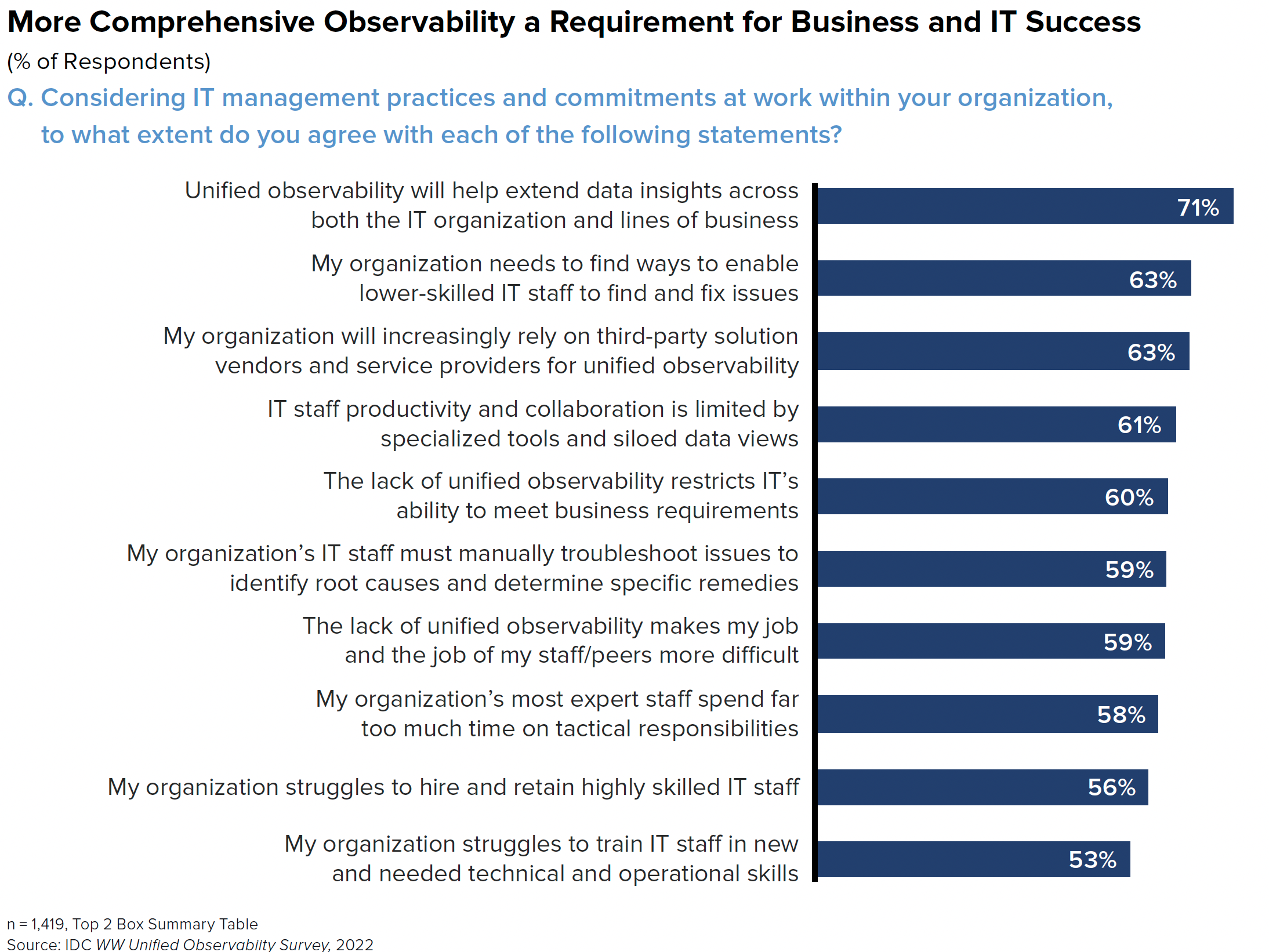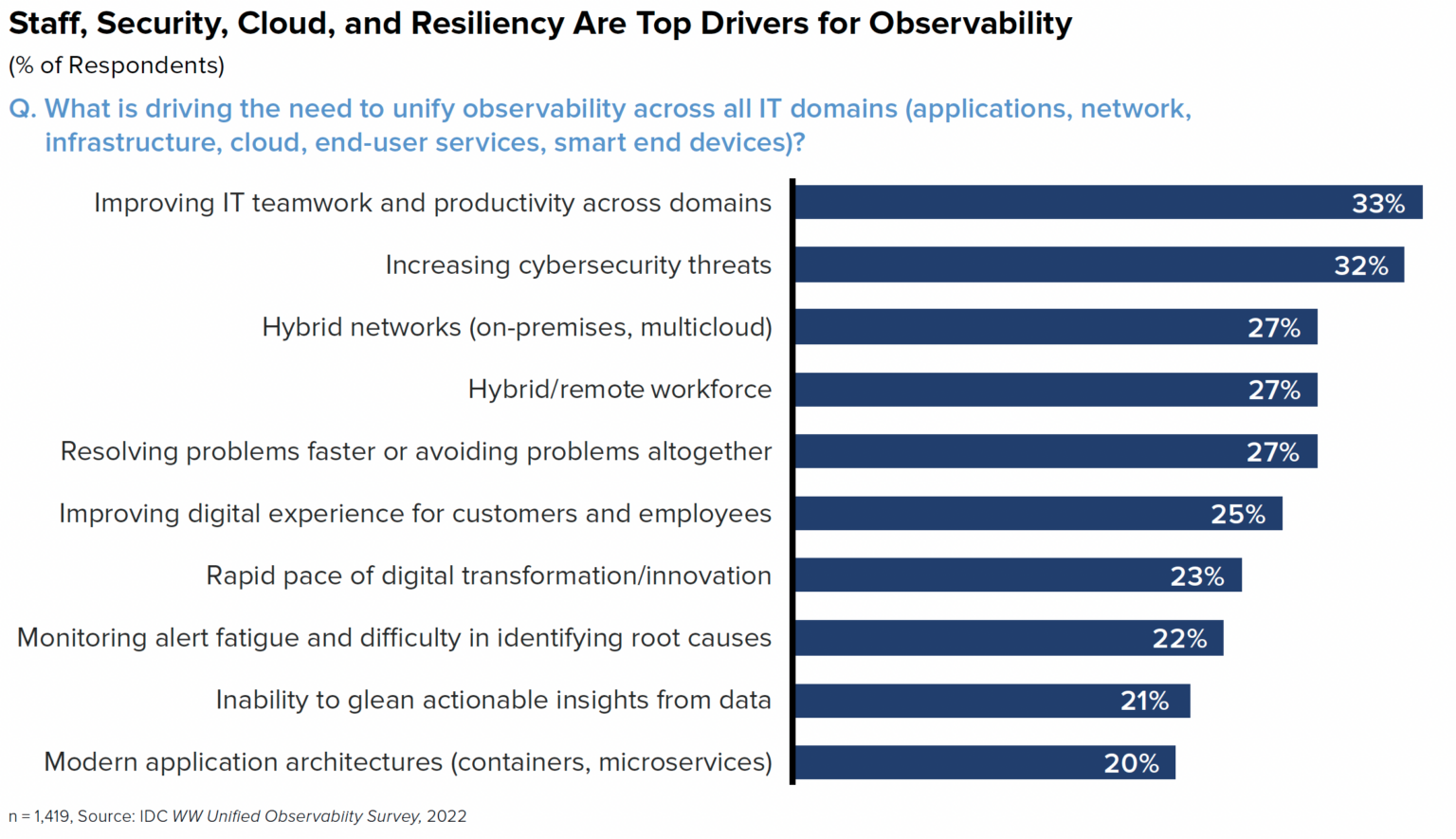Unified Observability is the Solution IT Has Been Waiting For
IT teams have been relying on observability tools to (theoretically) provide intelligence and insights into operating conditions within an organization’s digital infrastructure for years. But most of these tools have come with significant shortcomings that leave IT teams wanting more.
Riverbed recently worked with consulting firm IDC to survey over 1,400 IT professionals across the world to determine the current state of observability solutions, what IT professionals want to get out of observability, and how they’re planning to invest in these solutions.
This blog will highlight some of the key takeaways from the report, including how IT teams look to achieve true unified observability. If you want to jump straight into the full report you can download The Shift to Unified Observability in Management: Reasons, Requirements, and Returns.
The current state of observability
IDC’s survey reveals that over 90% of IT organizations currently use observability solutions. But when we drill down further, we see that IT teams aren’t exactly thrilled with current observability offerings.
- 61% of IT teams agree their productivity and collaboration is limited by specialized tools and siloed data views.
- 60% of IT teams believe their monitoring tools serve narrow requirements and fail to enable a unified and complete view into current operating conditions.
- 59% of IT teams must manually troubleshoot issues to identify root causes and determine specific remedies.
- 54% of organizations already use six or more discrete tools for IT monitoring and management.
Current solutions simply aren’t robust or unified enough, which leads to blind spots in visibility and forces IT teams to waste a lot of time troubleshooting problems.
Simply put, most observability tools on the market today are ineffective for addressing the changes of today’s distributed IT environments.
Unified Observability merges silos
When IDC asked the 1,400 survey respondents: What is driving the need to unify observability across all IT domains (applications, network, infrastructure, cloud, end user services, smart end devices)? The number one response was “Improving IT teamwork and productivity across domains.”
For too long, discrete monitoring and performance tools have failed to connect the dots between disparate users, teams, and networks. This problem has only been exacerbated by the shift to remote and hybrid work which has added layers of complexity to an already complex IT environment.
Riverbed’s Alluvio Unified Observability portfolio helps break down these silos by unifying data, insights, and actions across IT. With full-fidelity user experience, application, and network performance data on every transaction across the digital enterprise, Alluvio can apply AI and ML to correlate data streams and alerts to provide actionable insights across the business.
Unified Observability makes for happier IT talent
Survey results indicate that Unified Observability and its ability to leverage automation in remediating tech issues would help improve working conditions within IT teams. Consider the following:
58% of respondents agree that their organization’s most expert staff spend far too much time on tactical responsibilities. Meanwhile, 56% also agreed their organization struggles to hire and retain highly skilled IT staff.
That is a recipe for disaster as organizations are forced to leverage their hard to find and retain staff on responsibilities far below their skill (and pay) level. It makes sense then that IDC research reveals IT managers have a strong desire to redirect staff from tactical duties to strategic responsibilities.
Alluvio Unified Observability can help organizations do just that. It begins with capturing full-fidelity user experience, application, and network performance data on every transaction across the digital ecosystem. It then applies AI and ML to contextually correlate disparate data streams and provide actionable insights. With these actionable insights, you can automate the investigative workflows of IT experts, empowering your entire IT staff to solve complex problems quickly and accurately.
The need for Unified Observability
Over 70% of the survey respondents believe Unified Observability is critical to delivering the best possible digital experiences for customers and employees. At the same time, 60% say that the lack of Unified Observability restricts the ability of IT teams to meet business requirements. And 59% say the absence of Unified Observability makes their job and the job of their staff and peers more difficult.
Most IT organizations understand the promise of truly unified observability solutions but until now have been forced to patch together disparate monitoring and performance tools. With Alluvio Unified Observability, organizations can finally eliminate the data silos, resource-intensive war rooms, and alert fatigue that has plagued discrete monitoring tools for years. They can truly enable cross-domain decision-making, apply expert knowledge more broadly, and continuously improve digital service quality for their customers and employees.
Register for the Riverbed Webinar: The Shift to Unified Observability
Guest Author: Mike Marks, VP Product Marketing, Riverbed Technology
As Vice President of Product Marketing, Mike Marks is responsible for sales enablement, go-to market planning and execution, and product marketing. Mike joined Riverbed through its acquisition of Aternity.
Wondering how to get started on your own path to Unified Observability? For a limited time only, Teneo is offering a free, 2-hour consultation to help you reassess your monitoring and visibility needs and share best practices for adopting a Unified Observability strategy. Find out more and book your consultation.




